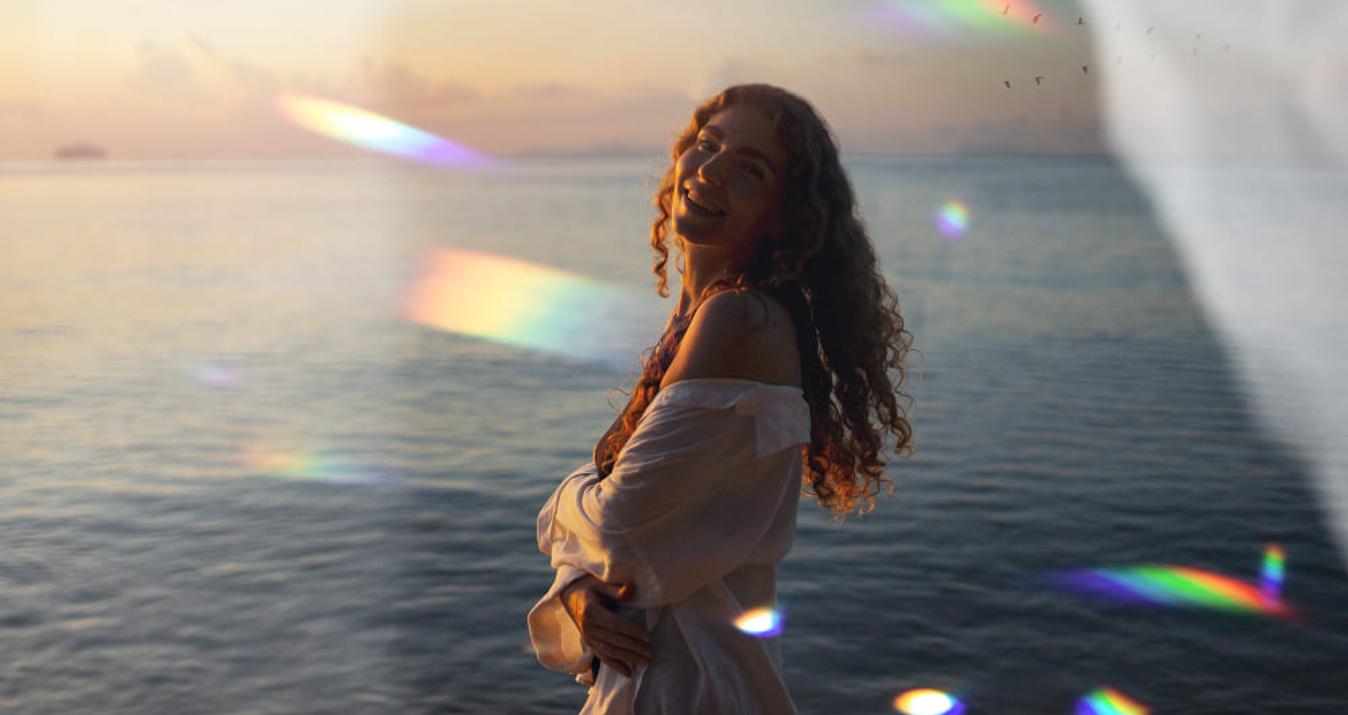Top Five Photography Spots in Namibia by Daniel Kordan
March 04, 2019

Check out the best photography locations in Namibia, appropriate gear and shooting times for each of them.
With endless dunes stretching for hundreds of kilometers, abandoned houses, rocky mountains, and soils that look like the Martian surface, Namibia should put some wind in your photography sails. Watch, enjoy, and get inspired:
1. Spitzkoppe
Rising an impressive 1 728 metres above the ground, Spitzkoppe is a striking landmark on the Namibian landscape. Due to its distinctive form, which can be spotted from a great distance, the Spitzkoppe is often called the “Matterhorn” of Namibia.
How to get there: Spitzkoppe is located around 180 kilometers from Swakopmund and 280 kilometers from Windhoek. To get there, travel along the B2 highway. Drive past Usakos, then in 24 kilometers take the D1918 gravel road to Henties Bay and drive 18 kilometers until you see a turn off to D3716 – this is the road to Spitzkoppe.
Spitzkoppe is a stunning natural wonder which is undeservedly ignored by photographers. In the photo you see what an exciting place it is. This is a famous natural arch captured at sunset. I was really lucky to catch the last sun rays! And the man in the center, our guide, shows the greatness of the location. To make this pan, I used a Nikon D850 with the Nikkor 14-24mm.
When to shoot: The best time to shoot Spitzkoppe is at sunrise or sunset. This gives you a great chance to capture the contrasting light and shadow patterns. Spend a couple of hours in the area if you want to get really good shots.
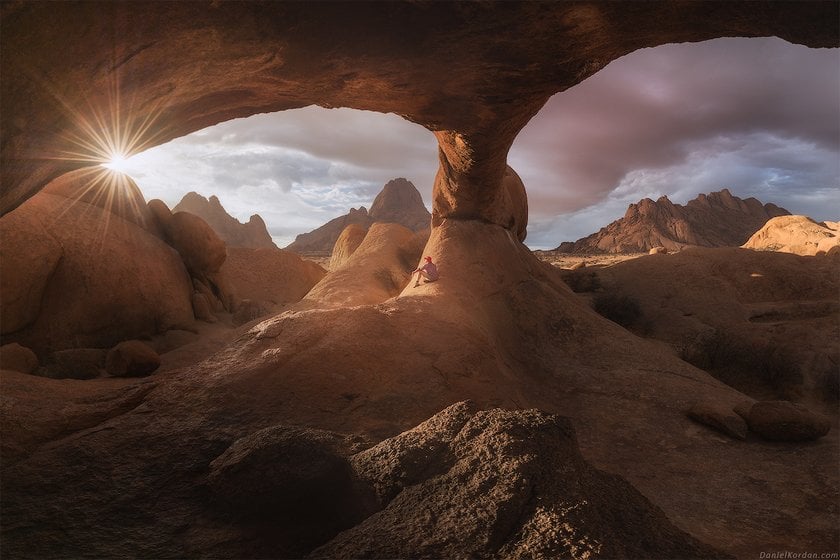 Spitzkoppe Arch. Photo made with Nikon D850, 14-24mm lens, edited with Luminar 3.
Spitzkoppe Arch. Photo made with Nikon D850, 14-24mm lens, edited with Luminar 3.2. Deadvlei
At the end of the Tsauchab Dune Valley is the famous Deadvlei, which was cut off from Sossusvlei by a low dune an estimated 700-800 years ago. The lack of water, arid climate and hard wood of the Namibian Camel Thorn tree has kept the trees of Deadvlei from decomposing. The result is a collection of ghostly trees rising from a cracked white clay surface. The pan is deceptively large and offers about 50 of the oddly shaped trees to photograph. The location can be overwhelming at first, but with a great guide it’s easy to find the best trees and photograph them in all their glory.
How to get there: Deadvlei is located 68 kilometers from the Sesriem gate. The last six kilometers can only be driven with a four-wheel drive or walked. Be aware: there’s no shade, and you’ll be walking through the desert the whole way, so make sure to take plenty of water and sunscreen.
This night photo isn’t actually one photo. It’s composed of up to 700 shots, each with a 25-second exposure. The gear I used is a Nikon D850 with a 14–24mm lens at f/2.8 and ISO 5000. Deadvlei is a unique place and difficult to get to, especially at sunset or sunrise. To get a desirable shot, you’d better stay right in the park for a night. Just rent a lodge and take your time for shooting.
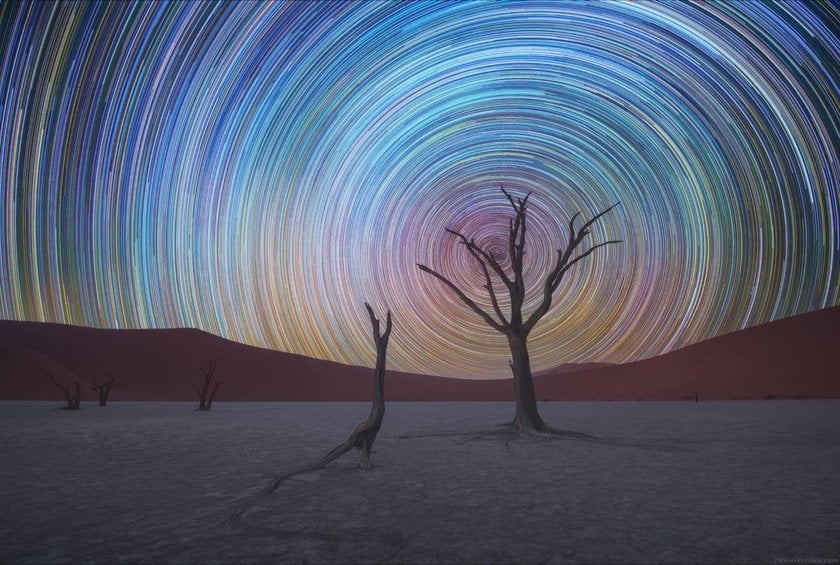 Deadvlei. Photo made with Nikon D850, 14–24mm lens, f2.8 and ISO 5000, edited with Luminar 3.
Deadvlei. Photo made with Nikon D850, 14–24mm lens, f2.8 and ISO 5000, edited with Luminar 3.When to shoot: It’s best to rent a lodge and stay inside the Sossusvlei park for a night to capture the sunset and sunrise. Deadvlei is a paradise for photographers as altogether the blue sky, red dunes, and white clay pans make a striking vision.
 Deadvlei. Photo made with Nikon D850, edited with Luminar 3.
Deadvlei. Photo made with Nikon D850, edited with Luminar 3.
3. Sossusvlei Sand Dunes
Sossusvlei is one of a kind landscape created by an ancient river flowing into the desert. Like several other rivers in Namibia, the Tsauchab River used to flow from the mountains, through the desert, all the way to the coast. Thousands of years ago it was cut off from the ocean by the expanding desert and this created a seasonal wetland among the dunes. Over the millennia, this wetland has retreated inland as the Namib Desert slowly reclaims the valley that the river cut through the dunes.
As it stands today, Sossusvlei is about 60 kilometers from the coast, but still 40 kilometers into the towering red dunes of the Namib Desert. Although the river only flows all the way to Sossus a few times every decade, the valley still sustains a large population of wildlife among the dunes.
How to get there: There’s only one bumpy way – 65 kilometers away from the Sossusvlei dry oasis you can find accommodation close to the dunes in the campsite at Sesriem. Although it takes time and effort to get that far, the feeling of vastness and space is well worth it.
When to shoot: This dreamscape was captured at 9 am, when the sun creates beautiful shadows on the dunes. The 400mm lens squeezes the space to show the scale of the immense Namibian sand dunes.
 Sossusvlei Dune. Photo made with Nikon D850, 400mm lens, edited with Luminar 3.
Sossusvlei Dune. Photo made with Nikon D850, 400mm lens, edited with Luminar 3.
4. Kolmanskop Ghost Town
Situated just 5 minutes from Luderitz, Kolmanskop is the long-forgotten site of one of the greatest diamond rushes in human history. In the 19th century, German mining companies invested a fortune to build an entire town in the middle of nowhere. Everything from the doorframes to the paint was imported from Germany and today the desert is reclaiming this once-glorious town. Despite being flooded with sand, the dry climate has done an amazing job of preserving the colorful rooms. There are well over 25 rooms worth photographing, so everyone can do their own thing.
How to get there: Drive around 12 kilometers from Luderitz and you’ll find the incredible ghost town of the Namib desert.
When to shoot: It’s great to shoot the interiors of еmрtу local houses during the daylight or at sunset. With the dunes inside of the houses, you’ll get really thrilling photographs. When shooting at night, use an artificial source of light, like a lamp, and enjoy fantastic shots with captivating star trails.
This photo, for example, was taken in the former school building and now the dune is its only habitat. It was really scary to be there so I put on the lamp, which produced a soft light beneficial for the photo shoot.
 Former school building in Kolmanskop, edited with Luminar 3.
Former school building in Kolmanskop, edited with Luminar 3.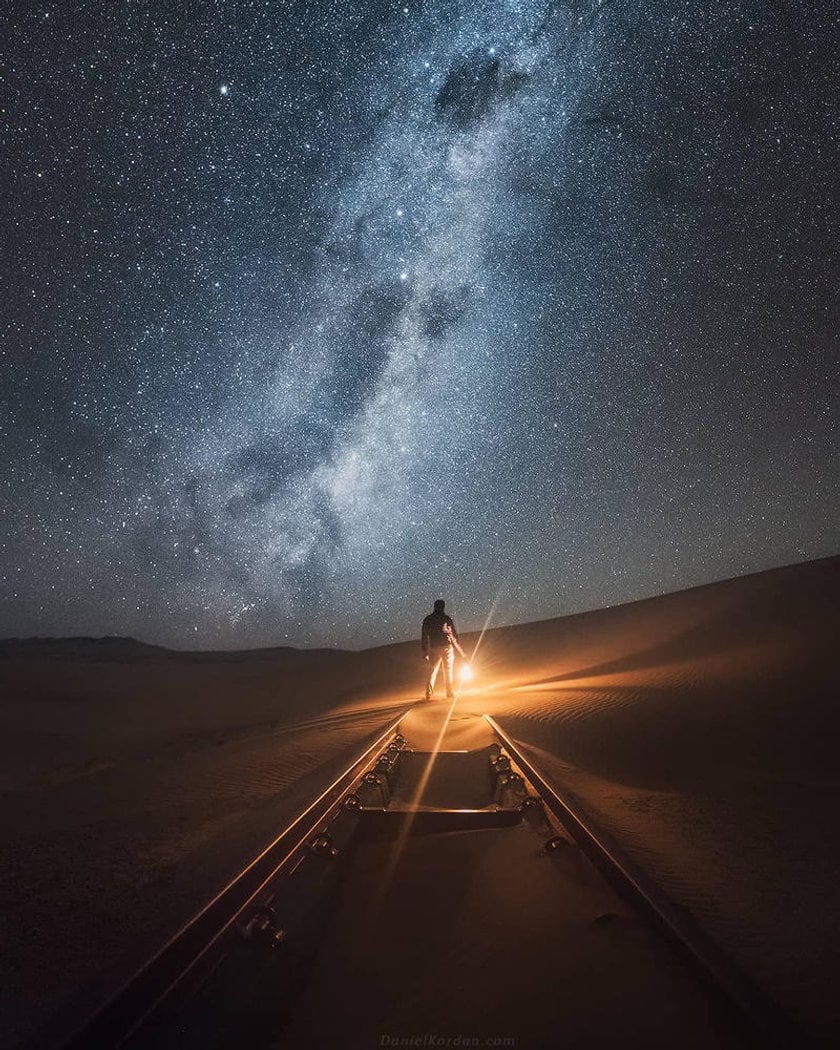 Abandoned railway and Milky Way in Kolmanskop, edited with Luminar 3.
Abandoned railway and Milky Way in Kolmanskop, edited with Luminar 3.5. Quiver Tree Forest and Giant’s Playground
Found only in Southwestern Africa, Quiver “Trees” are actually very large succulent plants. With their cracked golden-white bark and remarkable shape, they make great photographic subjects.
How to get there: This attraction can be found 14 kilometers north of Keetmanshoop, on the road to Koës. The forest is in the Gariganus farm. You can stay at the Mesosaurus fossil camp, where a friendly master can show his farm covered by more than 5,000 quiver trees (the botanical name is Aloidendron dichotomum).
As if brought by aliens to our planet, quiver trees with their odd shape and thorns appear to be very popular among travel photographers. These plants got this name because the locals used them to make quivers for arrows. The night is a special time for capturing a Milky Way in this area – though it’s almost invisible in the shot, the shape can be clearly seen. This pan is made of four vertical shots, with a 14mm lens.
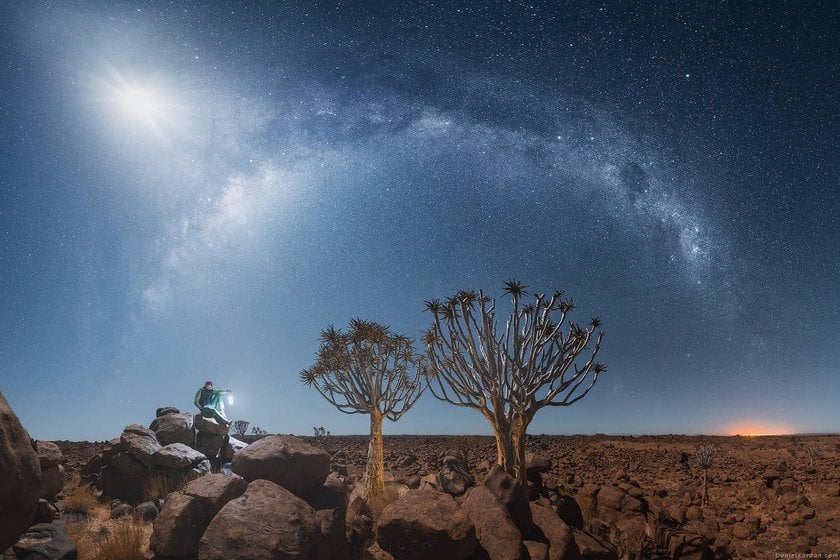 Quiver Tree Forest. Photo made with Nikon D850, 14mm lens, edited with Luminar 3.
Quiver Tree Forest. Photo made with Nikon D850, 14mm lens, edited with Luminar 3.When to shoot: As there are a very few people in the forest and only photographers wander here and there to find the right place for the best shot, you can leave your camera for a whole night and make time-lapse star trails just like in the photo above.
Namibia is a massive, desolate landscape and its endless vistas will be permanently etched into your soul. Namibia’s desert winds have sculpted the world’s highest dunes out of red sand and it is these dunes that make the Namibian landscape like no other on earth.
All photos edited with Luminar 3.
Originally the text was published at FStoppers.com.
Subscribe to the Skylum YouTube Channel





